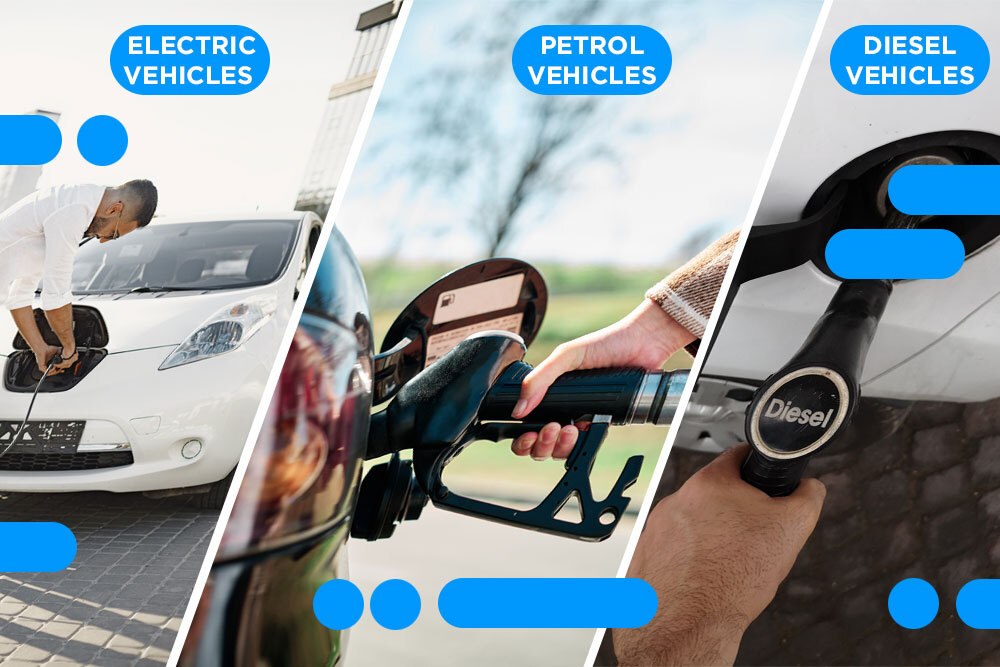
Electric Vehicles Vs Petrol & Diesel Vehicles
AutoHealth Admin 10/7/2024
The invention of automobiles helped put the progress of society as a whole on the fast track.
If Ford did not introduce the Model T or Volkswagen did not introduce the Beetle back in the day, who knows, the smartphone you are holding to read this blog might have been nothing more than pure science fiction!
Anyway, we are getting sidetracked here.
Presently, electric, petrol and diesel vehicle are available in the mass market segments. Sure, there are hydrogen vehicles as well but their availability is very limited. This is why we are going to focus on everything you need to know about electric, petrol and diesel cars, in the following sections.
Let’s begin now, shall we?
Electric cars
The overall condition of global air has deteriorated over the centuries especially with the advent and widespread adoption of industrialization.
In recent years, global authorities decided that something needs to be done in a bid to arrest the runaway global air pollution. The solution is electrification of automobiles. Lo and behold, EVs were introduced to the mass markets.
How do electric vehicles work?
Electric Vehicles – how do they work?
Well, the clue is in their name!
EVs use electricity to power on-board electric motors which in turn power their wheels.
The only difference is that instead of being hooked directly to an overhead power supply like a tram or a third rail like metro trains; EVs draw the power they need to move from on-board battery packs, affixed to the floor of their chassis.
Types of electric vehicles
There are three types of electric vehicles currently available in the mass markets.
They are as follows -
- HEVs (Hybrid electric vehicles) – have a battery pack that powers the electric motors which powers the driving wheels. However, instead of charging the vehicle from a power outlet, HEVs have a small internal combustion engine which kicks in the moment the battery pack of the vehicle depletes beyond a certain level. As soon as the battery pack aboard the HEV is charged by the IC engine, it switches itself off and the HEV reverts to its fully electric mode.
- PHEVs - are HEVs with the additional advantage that they can be plugged in to charge their on-board battery packs.
- BEVs (Battery Electric Vehicles) – are powered by their on-board battery packs but their battery packs can only be charged by plugging the vehicle to a charger or a power outlet.
Positives and negatives of EVs
Positives- EVs are energy efficient since a large percentage of the energy stored in their battery packs are used up to move the vehicle minus any emissions
- Minimal servicing, no oil changes, etc. meaning low maintenance costs
- Minimal environmental impact
- The initial cost of an EV is pretty hefty which is a turnoff for the majority of would-be EV owners
- Compared to IC powered cars, EVs will always have a lower range
- Charging an EV is not convenient since you have to spend at least an hour or more to restore at least 50 per cent charge of your EV after its battery pack has depleted
Petrol Vehicles
Petrol vehicles generate power by burning a mix of air and fuel (in this case petrol) using the Otto cycle. The air is sucked in by the downward motion of the piston and the fuel is sprayed into the combustion chamber by electronically controlled fuel injectors. The air and fuel mix is then ignited in the combustion chamber with the electric spark generated by spark plug(s).
Positives and negatives of petrol vehicles
Positives- Petrol cars are cheaper than EVs and diesel vehicles
- Petrol cars are known for their rapid accelerations and responsive nature
- Petrol engines run silently, especially when compared to the grunt and rumble of diesel engines
- Petrol engine-equipped car maintenance sessions are relatively cheap
- Petrol engines are known for their low fuel efficiency
- Petrol engines tend to have shorter operational lives
- Due to their low torque outputs, petrol engines don’t have much demand in the commercial vehicle sector
Diesel Vehicles
Diesel engines work using the Diesel cycle – where the diesel fuel is mixed with atmospheric air inside the cylinder of the engine. The fuel air mixture is then compressed to an extent which automatically ignites it.
Diesel engines produce high torque at low RPM even if their initial accelerations are poor especially compared to petrol engines. Diesel engines are known for their fuel efficient nature and at the same time, their operational lives are longer when compared to petrol engines.
However, diesel engine-equipped vehicles are known for their higher sticker prices and maintenance costs.
Positives and negatives of diesel vehicles
Positives- Diesel engine-equipped vehicles are fuel efficient and have high resale value
- Diesel engines-equipped vehicles are ideal for hauling cargo
- Diesel engines are pretty underpowered especially when one considers their acceleration
- Diesel engines emit a lot of tailpipe emissions, compared to petrol vehicles
Fossil fuel cars are here to stay
Fossil fuel vehicles are here to stay.
Complete eradication of fossil fuel vehicles is a fantasy which is being proven time and again by both mass market and premium vehicle manufacturers.
For instance, take note of Pagani that recently announced that they are going to stick with their V12s and have ditched their plans to develop an EV!
Sure EVs are convenient and less harmful for the environment but hey, who doesn’t love a vehicle that roars to life as soon as you turn its ignition on?